Genetic variability, heritability and genetic advance studies for yield and quality traits among diverse genotypes of tomato (Lycopersicon esculentum Mill)
Bạn đang xem bản rút gọn của tài liệu. Xem và tải ngay bản đầy đủ của tài liệu tại đây (349.88 KB, 7 trang )
Int.J.Curr.Microbiol.App.Sci (2018) 7(9): 1391-1397
International Journal of Current Microbiology and Applied Sciences
ISSN: 2319-7706 Volume 7 Number 09 (2018)
Journal homepage:
Original Research Article
/>
Genetic Variability, Heritability and Genetic Advance Studies
for Yield and Quality Traits among Diverse Genotypes of
Tomato (Lycopersicon esculentum Mill)
Pramod Kumar1*, Lila Bora1, V.K. Batra1 and Niteen Kumar Sheena2
1
Department of Vegetable Science, 2Department of Genetics and Plant Breeding, Chaudhary
Charan Singh Haryana Agricultural University, Hisar-125004, Haryana, India
*Corresponding author
ABSTRACT
Keywords
Tomato, Variability,
Heritability,
Genetic advance
Article Info
Accepted:
10 August 2018
Available Online:
10 September 2018
The present experiment was carried out to investigate yield and quality traits in tomato, in
order to generate information regarding the extent of genetic variability, heritability and
genetic advance at Regional Research Station, Uchani, Karnal, CCS Haryana Agricultural
University, Hisar, Haryana during autumn seasons of 2016 and 2017 involving 43
genotypes. The analysis of variance indicated significantly higher difference among the
treatments for all the traits studied indicating presence of substantial amount of genetic
variability among the materials studied. Analysis of coefficient of variation inferred that,
the magnitude of phenotypic coefficient of variation (PCV) was slightly higher over
genotypic coefficient of variation (GCV) for all the traits under study except specific
gravity referring that they were much influenced by environmental factors. Further, the
estimates of heritability and genetic advance were found higher for total fruit yield per
plant, early fruit yield per plant, plant height, total number of fruits per plant and total
soluble solids indicating scope of direct selection for improvement of these traits.
Introduction
Tomato (Lycopersicon esculentum Mill.) is
considered as one of the most popular and
widely grown vegetable crops throughout the
India and world. It is widely grown vegetable
crop in the world next only to potato. It also
has higher rank among forcing vegetables due
to its remunerative price and round the year
demand. In many countries it is considered as
“Poor man‟s orange” because of its attractive
appearance and nutritional value (Singh et al.,
2004). Tomato is considered as „Protective
food‟ in medicinal dictionary because of its
some special nutritional value and antioxidant
properties mainly due the pigment lycopene
and different flavonoids (Septa et al., 2013).
Present scenario about tomato production and
productivity in India is far below than the
world. There is need to develop varieties and
hybrids superior than available for different
agro-ecological conditions with specific end
use.
1391
Int.J.Curr.Microbiol.App.Sci (2018) 7(9): 1391-1397
Genetic resources enable plant breeders to
create novel plant gene combinations and
select crop varieties more suited to the needs
of diverse agricultural systems (Glaszmann et
al., 2010). The importance of genetic
variability was perceived for the first time by a
Russian scientist, Vavilov (1951), who
advocated that wide range of variability
provides better scope for selecting a desirable
genotype. The efficiency of selection depends
on the nature and extent of genetic variability,
degree of transmissibility of desirable
characters and on the expected genetic gain
for the character in a population (Golani, et
al., 2007). The total variability present in
germplasm can be divided into heritable and
non-heritable components through genetic
parameters like phenotypic and genotypic
coefficients of variation, heritability and
genetic advance. The heritable portion of
phenotypic variation is referred as heritability.
It is an important index of characters
transmission from parents to offspring
(Falconer, 1981). The estimate of heritability
helps in the selection of elite genotypes from
diverse population. Genetic advance refers
amount of improvement made over parents
due to selection. Heritability and genetic
advance are playing a crucial role in effective
selection for a target trait. Estimation of
genetic variability and heritability of various
yield and quality traits will be helpful in
formulating selection strategies for these traits
in future breeding programme. Hence, the
present study focuses on assessment of
available genetic variability, heritability and
genetic advance for yield and quality traits in
among diverse genotypes of tomato.
Materials and Methods
The experiment was designed in randomized
complete block design (RCBD) comprising of
43 genotypes (13 parents and 30 crosses) with
three replications (Table 1). The seedlings
were planted at spacing of 60 cm from row to
row and 45 cm from plant to plant and all the
recommended cultural practices and plant
protection schedules were adopted for raising
the crop successfully. Five plants from each
replicated plots were selected randomly and
the data was recorded on 13 characters, viz.,
plant height, number of branches per plant,
days to 50% flowering, days to first
harvesting, early fruit yield per plant, number
of locules per fruit, fruit size (polar and
equatorial diameter), total number of fruits per
plant, total fruit yield per plant, specific
gravity, total soluble solids, ascorbic acid,
acidity and the computed mean values of
various characters were used for statistical
analysis. The analysis of variance was
calculated as per Gomez and Gomez (1983).
Phenotypic and genotypic coefficient of
variation was worked by the formula given by
Burton and De Vane (1953). Heritability
(broad sense) in per cent was estimated as per
the formula given by Burton and De Vane
(1953), Johnson et al., (1955) and Hanson et
al., (1956). Genetic advance and genetic gain
were calculated as per the formula suggested
by Lush (1949) and Johnson et al., (1955).
Results and Discussion
Mean performance and range
Analysis of variance showed a wide range of
variability among all the 43 genotypes studies
for 13 characters (Table 2). The combined
mean performance of genotypes for various
traits is presented in (Table 3 and 4). The
value of plant height varied from 62.67 cm
(DVRT-6) to 112.22 (PSH x PNR-7), while
the number of branches per plant was recorded
highest in P. Upma x PC (10.11) and lowest in
DVRT-2 x PC (5.11). Among the parents
DVRT-3 (40.0) recorded earliest for days to
50% flowering while DVRT-2 (58.0) most
late variety and among crosses the
combination DVRT-3 x H-86 (38.0) shown
most earliness.
1392
Int.J.Curr.Microbiol.App.Sci (2018) 7(9): 1391-1397
For days to 50% flowering, the parent S-7
(81.44) and cross PSH x PC (83.41) found
most early. The parent Pusa Sadabahar (0.7
kg) followed by Punjab Upma (0.64 kg) and
cross DVRT-5 x H-86 (0.73 kg) following
PSH x PNR-7 (0.72 kg) recorded for highest
early fruit yield/plant. Number of locules per
fruit varied from 2.08 (DVRT-6) to 4.25 (NT8 x PNR-7). The parent Punjab Chhuhara
(6.63 cm) and cross combination A. Vikas x
PC (5.55 cm) exhibited highest fruit polar
diameter while maximum fruit equatorial
diameter was found in DVRT-3 x PNR-7
(4.91 cm). Total number of fruits/plant was
recorded maximum in DVRT-6 x PC (48.03)
and minimum in DVRT-3 (19.22). Among the
parents, the variety Punjab Chhuhara (1379 g)
followed by S-7 (1340 g) and among crosses
DVRT-3 x PNR-7 (2314 g) preceded by A.
Vikas x PNR-7 (1918 g) recorded the fruit
yield/plant. The Specific gravity of fruits
recorded maximum value 1.18 g/cm3 for Pusa
Sadabahar and minimum value 0.95 g/cm3 for
A. Vikas x PC. Total Soluble Solids (TSS)
content ranged from 3.18 0Brix (H-86) to 5.24
0
Brix (PNR-7). Ascorbic acid content was
found maximum 29.37 mg/100 g juice content
(PSH x PC) and minimum 17.67 mg/100 g
juice content (Arka Vikas). The genotypes
DVRT-2 and DVRT-3 x H-86 recorded
minimum (0.52 %) and maximum (0.89 %)
acidity content among all the genotypes
studied respectively.
Phenotypic and Genotypic Coefficient of
Variation
Phenotypic coefficient of variation (PCV) was
higher than the corresponding genotypic
coefficient of variation (GCV) for all the
morphological traits under study except
specific gravity (Table 5). High phenotypic
and genotypic coefficient of variation was
recorded for total fruit yield per plant (29.71
% and 27.42 %), early fruit yield per plant
(29.44 % and 26.58 %), total number of fruits
per plant (22.7 % and 20.22 %) and plant
height (20.01 % and 18.08 %). Moderate
coefficient of variability at both phenotypic
and genotypic level was observed for number
of locules per fruit (18.23 % and 14.15 %),
number of branches per plant (17.86 % and
14.14 %), Polar diameter (17.61 % and 14.56
%) and ascorbic acid content (15.92 % and
14.97 %). Acidity (14.08 % and 13.36 %),
days to 50 % flowering (14.04 % and 13.24
%), total soluble solids (13.52 5 and 12.52 %)
and equatorial diameter (11.75 % and 5.17 %)
showed lower values for both phenotypic and
genotypic coefficient of variability.
Table.1 List of genotypes studied including parents and crosses
Sr. No.
1.
2.
3.
4.
5.
6.
7.
8.
9.
10.
11.
12.
13.
Parents
Pusa Sadabahar
Punjab Upma
S-12
DVRT-6
DVRT-2
DVRT-5
NT-8
DVRT-3
S-7
Arka Vikas
Punjab Chhuhara
PNR-7
H-86
Sr. No.
1.
2.
3.
4.
5.
6.
7.
8.
9.
10.
11.
12.
13.
Crosses
PSH x PC
P. Upma x PC
S-12 x PC
DVRT-6 x PC
DVRT-2 x PC
DVRT-5 x PC
NT-8 x PC
DVRT-3 x PC
S-7 x PC
A. Vikas x PC
PSH x PNR-7
P.Upma x PNR-7
S-12 x PNR-7
Sr. No.
14.
15.
16.
17.
18.
19.
20.
21.
22.
23.
24.
25.
26.
1393
Crosses
DVRT-6 x PNR-7
DVRT-2 x PNR-7
DVRT-5 x PNR-7
NT-8 x PNR-7
DVRT-3 x PNR-7
S-7 x PNR-7
A.Vikas x PNR-7
PSH x H-86
P. Upma x H-86
S-12 x H-86
DVRT-6 x H-86
DVRT-2 x H-86
DVRT-5 x H-86
Sr. No.
27.
28.
29.
30.
Crosses
NT-8 x H-86
DVRT-3 x H-86
S-7 x H-86
A.Vikas x H-86
Int.J.Curr.Microbiol.App.Sci (2018) 7(9): 1391-1397
Table.2 Analysis of variance (Mean sum of squares) for different characters
Sr. No.
Characters
Replication
(2#)
Plant height (cm)
100.12
1.
Number of branches per plant
1.48
2.
Days to 50% flowering
7.11
3.
Days to first harvesting
16.34
4.
Early fruit yield per plant (kg)
0.00
5.
Number of locules per fruit
0.07
6.
Fruit size (cm)
7.
a).
Polar diameter
0.16
b).
Equatorial diameter
0.30
Total number of fruits per plant
2.08
8.
Total fruit yield per plant (g)
75270.37
9.
Specific gravity (g/cm3)
0.00
10.
Total soluble solids (0Brix)
0.03
11.
Ascorbic acid (mg/100g fruit juice)
9.49
12.
Acidity (%)
0.00
13.
#
degree of freedom, * significant at 5% level of significance
Mean Squares
Genotype
(42#)
647.32*
4.35*
136.17*
56.85*
0.06*
0.80*
Error
(84#)
45.01
0.72
5.44
5.07
0.00
0.14
1.17*
0.32*
131.84*
373538.43*
0.01*
0.90*
35.90*
0.03*
0.16
0.19
10.51
20431.53
0.00
0.05
1.50
0.00
Table.3 Mean performance of parents
Parents /
Crosses
Plant
height
(cm)
No. of
branches
per
plant
Days to
50%
flowering
Days to
first
harvesting
Early
fruit
yield/plant
(kg)
No. of
locules
Polar
dia.
(cm)
Equatorial
dia. (cm)
Total no.
of
fruits/plant
Fruit
yield/plant
(g)
SG*
(g/cm3)
TSS
(0Brix)
Ascorbic
acid
mg/100gm
juice)
Acidity
(%)
Punjab
Chhuhara
PNR-7
73.44
7.22
53.20
91.98
0.44
2.40
6.63
3.96
29.55
1379
0.97
4.30
24.47
0.60
107.56
8.67
52.30
90.44
0.43
2.82
3.47
4.18
26.69
567
1.03
5.48
21.18
0.70
H-86
66.67
7.00
51.30
85.44
0.49
4.07
3.74
4.30
19.47
1160
0.98
3.18
23.67
0.73
Pusa
Sadabahar
Punjab
Upma
S-12
70.56
7.67
45.33
83.33
0.70
3.53
3.22
4.13
32.65
1067
1.18
5.13
27.67
0.82
64.61
6.55
52.30
84.67
0.64
2.52
4.70
4.31
24.03
1207
0.98
3.84
25.67
0.78
65.56
6.67
48.10
84.44
0.49
3.84
3.42
4.02
31.72
953
1.03
4.42
27.27
0.77
DVRT-6
62.67
7.56
47.50
85.78
0.53
2.08
3.49
3.38
42.17
1153
1.02
4.48
21.87
0.74
DVRT-2
72.33
7.44
58.00
95.33
0.51
4.23
4.22
4.55
25.05
1082
1.04
4.08
20.00
0.52
DVRT-5
64.89
9.33
50.10
84.78
0.32
2.20
3.64
3.49
43.52
1037
1.05
4.42
20.82
0.83
NT-8
63.00
8.33
48.60
84.67
0.36
3.67
3.44
4.24
35.87
1308
1.03
3.89
19.67
0.76
DVRT-3
69.33
6.78
40.00
83.89
0.22
3.33
3.82
4.49
19.22
564
1.02
3.91
27.13
0.77
S-7
64.67
7.56
42.33
81.44
0.36
3.30
3.68
4.28
31.13
1340
1.09
5.24
23.53
0.80
Arka
vikas
66.78
8.66
54.30
93.44
0.28
3.56
3.53
4.38
28.52
900
1.01
3.32
17.67
0.58
*Specific gravity
1394
Int.J.Curr.Microbiol.App.Sci (2018) 7(9): 1391-1397
Table.4 Mean performance of crosses
Parents/Crosses
PSH x PC
P. Upma x PC
S-12 x PC
DVRT-6 x PC
DVRT-2 x PC
DVRT-5 x PC
NT-8 x PC
DVRT-3 x PC
S-7 x PC
A. Vikas x PC
PSH x PNR-7
P. Upma x PNR-7
S-12 x PNR-7
DVRT-6 x PNR-7
DVRT-2 x PNR-7
DVRT-5 x PNR-7
NT-8 x PNR-7
DVRT-3 x PNR-7
S-7 x PNR-7
A. Vikas x PNR-7
PSH x H-86
P. Upma x H-86
S-12 x H-86
DVRT-6 x H-86
DVRT-2 x H-86
DVRT-5 x H-86
NT-8 x H-8 6
DVRT-3 x H -86
S-7 x H-86
A. Vikas x H -86
Mean
C.D.
CV (%)
SE (d)
SE(m) (+/-)
Plant
height
(cm)
77.89
71.44
71.67
77.56
70.89
67.22
68.67
66.22
73.44
85.11
112.22
102.00
92.78
108.89
105.78
97.56
99.44
94.56
105.67
91.78
65.22
67.22
71.22
77.89
69.11
75.11
70.56
73.78
74.11
76.44
78.35
10.91
8.57
5.48
3.88
No. of
branches
per plant
8.78
10.11
6.78
9.00
5.11
7.00
8.78
8.00
7.11
8.55
8.11
7.11
9.78
8.22
8.89
7.33
8.44
7.78
9.56
9.78
7.78
7.67
9.56
8.22
5.11
7.11
7.00
6.22
5.45
7.00
7.78
1.37
10.92
0.69
0.49
Days to
50%
flowering
43.33
55.67
55.00
55.67
58.33
46.33
44.00
46.00
55.33
60.00
47.33
49.67
51.67
58.00
58.33
62.67
44.00
44.00
52.00
62.00
48.33
44.00
42.00
42.00
53.33
42.00
42.33
38.00
50.67
48.00
49.85
3.79
4.84
1.90
1.35
Days to
first
harvesting
83.41
92.83
92.33
88.87
94.70
93.44
85.20
85.56
92.47
94.75
84.67
85.97
85.73
93.41
94.88
95.33
83.95
84.91
87.34
96.38
86.50
85.47
84.12
85.88
92.75
84.34
84.08
84.16
85.92
85.53
88.04
3.67
2.56
1.84
1.30
Early fruit
yield/plant
(kg)
0.61
0.46
0.60
0.54
0.33
0.40
0.49
0.65
0.61
0.47
0.72
0.66
0.45
0.44
0.33
0.38
0.51
0.71
0.65
0.68
0.41
0.71
0.65
0.39
0.44
0.73
0.52
0.64
0.52
0.27
0.50
0.11
2.94
0.05
0.04
No. of
locules
2.39
2.56
3.24
2.83
3.26
2.92
3.53
3.43
3.67
2.79
3.09
2.96
3.33
3.47
3.40
2.76
4.25
3.62
2.99
3.36
3.33
3.62
3.38
2.87
3.53
4.02
3.80
3.56
3.44
3.20
3.27
0.62
11.63
0.31
0.22
Polar
dia.
(cm)
5.11
4.66
3.98
4.33
4.11
3.96
3.67
4.33
3.93
5.55
3.96
4.28
3.85
3.17
3.87
4.66
3.69
4.15
3.51
3.73
3.80
4.20
3.96
3.89
4.26
3.65
3.81
4.04
3.64
3.71
4.00
0.64
9.91
0.32
0.23
1395
Equatorial
dia.
(cm)
3.98
4.04
4.07
3.86
3.91
4.04
4.20
4.40
4.54
4.27
3.99
4.16
4.23
3.98
4.23
4.46
3.93
4.91
4.17
4.71
4.05
4.71
4.35
4.44
4.61
4.28
4.02
4.58
4.19
4.39
4.20
0.7
10.3
0.35
0.25
Total no. of
fruits/plant
44.82
32.94
35.89
48.03
25.20
25.83
29.93
26.07
34.96
30.20
41.41
32.28
32.04
34.34
22.10
26.13
33.07
37.96
32.10
30.03
28.43
30.18
31.93
36.04
20.36
42.46
34.50
28.23
29.89
26.87
31.45
5.28
10.3
2.65
1.88
Fruit
yield/plant
(g)
1680
1036
1174
1910
796
1283
1171
1468
1677
932
1520
1021
1154
914
978
1213
1441
2314
1344
1918
959
1402
1314
1509
1358
1913
1306
1530
1016
918
1251
232.42
11.43
116.71
82.53
SG
(g/cm3)
TSS
(0Brix)
0.98
0.96
1.03
1.01
1.08
0.96
0.99
1.09
0.97
0.95
1.02
0.98
0.98
1.14
1.03
0.98
1.05
0.98
0.98
1.04
0.97
0.98
1.03
1.05
1.08
1.05
1.04
1.10
1.04
0.98
1.02
0.05
3.05
0.02
0.01
3.94
4.37
4.62
3.70
4.29
3.56
5.05
3.92
3.73
4.83
4.57
4.56
3.50
4.69
4.35
3.67
4.93
3.53
4.64
4.87
3.95
3.97
4.40
3.50
3.93
4.43
4.87
4.19
5.03
4.12
4.26
0.35
5.11
0.18
0.13
Ascorbic acid
(mg/100gm
juice)
29.37
21.47
28.57
21.43
23.07
21.33
19.50
26.67
23.60
18.40
26.17
18.03
27.90
22.03
18.33
20.40
18.67
27.34
20.63
18.20
27.40
20.90
27.07
20.13
18.23
21.00
21.07
26.80
19.93
20.10
22.62
1.90
5.40
1.0
0.71
Acidity
(%)
0.86
0.62
0.66
0.63
0.56
0.66
0.74
0.70
0.62
0.55
0.76
0.71
0.61
0.58
0.60
0.58
0.78
0.79
0.74
0.58
0.74
0.78
0.82
0.84
0.59
0.78
0.83
0.89
0.75
0.65
0.71
0.04
3.62
0.021
0.015
Int.J.Curr.Microbiol.App.Sci (2018) 7(9): 1391-1397
Table.5 Mean, Range, PCV, GCV, Heritability and Genetic advance of 13 morphological traits
of 43 different tomato genotypes
Sr.
No.
Characters
1.
2.
3.
4.
5.
6.
7.
a)
b)
8.
9.
10.
11.
12.
Plant height (cm)
Number of branches per plant
Days to 50% flowering
Days to first harvesting
Early fruit yield per plant (kg)
Number of locules per fruit
78.35
7.78
49.85
88.04
0.5
3.27
Polar diameter
Equatorial diameter
Total number of fruits per plant
Total fruit yield per plant (g)
Specific gravity (g/cm3)
Total soluble solids (0Brix)
Ascorbic acid (mg/100g fruit
juice)
Acidity (%)
13.
Mean
Range
Min.
Max.
PCV
(%)
GCV
(%)
Heritability
20.01
17.86
14.04
5.37
29.44
18.23
18.08
14.14
13.24
4.72
26.58
14.15
81.69
62.69
88.90
77.30
81.54
60.22
4.0
4.2
31.45
1251
1.02
4.26
22.62
62.67
112.22
6.55
10.11
38.0
62.67
81.44
96.38
0.22
0.73
2.08
4.25
Fruit size (cm)
3.22
6.63
3.38
4.91
19.22
48.03
564
2314
0.95
1.14
3.32
5.24
17.67
29.37
Genetic
advance (as
% of mean)
16.94
2.48
1.00
1.80
20.45
3.10
17.61
11.75
22.70
29.71
5.06
13.52
15.92
14.56
5.17
20.22
27.42
5.06
12.52
14.97
68.35
19.40
79.37
85.21
99.96
85.83
88.41
2.80
2.17
7.04
26.35
0.97
4.16
2.89
0.71
0.52
14.08
13.36
90.00
2.77
0.86
A critical perusal of data showed that days to
first harvesting had very less difference
between PCV and GCV (5.37 % and 4.72
respectively) indicating that the variation
present was mainly due to genotype. One of
the 13 characters, specific gravity showed
similar value for both PCV and GCV (5.06
and 5.06) indicating that the character was
fully governed by the genotype.
Heritability and genetic advance
Higher value for heritability along with high
genetic advance as per cent of mean was
recorded for total fruit yield per plant (85.21
% and 26.35 % respectively), plant height
(81.69 % and 16.94 % respectively) and early
fruit yield per plant (81.54 % and 20.45 %
respectively).
This indicated that selection for these traits
may be highly effective as these traits are less
influenced
by
environmental
factors.
Similarly, a joint consideration of heritability,
GCV and genetic advance revealed high value
2
h bs (%)
for total fruit yield per plant, early fruit yield
per plant and plant height.
Based upon the results recorded in this
experiment of 43 genotypes of tomato, it
could be concluded that total fruit yield per
plant, early fruit yield per plant, total number
of fruits per plant, days to first harvesting,
ascorbic acid content, Total Soluble Solids
(TSS) and plant height are the most important
characters for which straight selection may
bring worthwhile improvement in identifying
superior genotypes of tomato.
Acknowledgement
The Author would like to acknowledge the
financial support given by ICAR as NTS
during the M.Sc. degree programme and
would like to express sincere gratitude to Dr.
Lila Bora, Assistant Scientist and Major
Adviser, Division of Vegetable Science, Dr.
V. K. Batra, Professor and Head, Division of
Vegetable
Science,
CCSHAU-Hisar,
Haryana.
1396
Int.J.Curr.Microbiol.App.Sci (2018) 7(9): 1391-1397
References
Burton, G.W. and De Vane, E.M. 1953.
Estimating heritability from replicated
clonal material. Agron. J., 45: 478-481.
Falconer, D.S. and Mackay, T.F.C. 1981.
Introduction to quantitative genetics. 4th
ed. Longman Group, Essex. p., 464.
Glaszmann, J.C., Kilian, B., Upadhyay, H.D.
and Varshney, R.K. 2010. Accessing
genetic diversity for crop improvement.
Current Opinion in Plant Breeding.
13:167-173.
Golani, I.J., Mehta, D.R., Purohit, V.L.,
Pandya, H.M. and Kanzariya, M.V.
2007. Genetic variability and path
coefficient studies in tomato. Indian
Journal of Agricultural Research. 41
(2): 146-149.
Gomez, K.A. and Gomez, A.A. 1983.
Statistical procedures for Agricultural
Research. John Willey and Sons, Inc.,
New York. 357-427.
Hanson, C.H., Robinson, H.R. and Comstock
1956. Biometrical studies of yield in
segregating population in Korean
Leopedez. Agro. J., 48: 268-272.
Johnson, H.W., Robinson, H.F. and
Cornstock, R.E. 1955. Estimation of
genetic and environmental variability in
soybean. Agron. J., 47: 314-318.
Lush, J.L. 1949. Heritability of quantitative
characters in farm animals. Proceedings
of 85th congress on Genetic Heredity
(Suppl.), 356-375.
Septa, N. K., Septa, S. R., Septa, S. and
Kumar, A. 2013. Energy use efficiency
and cost analysis of tomato under
greenhouse and open field production
system at Nubra valley of Jammu and
Kashmir. Int. J. Environ Sci. 3(4): 12331241.
Singh, J.K., Singh, J.P., Jain, S.K. and Joshi,
A. 2004. Correlation and path
coefficient
analysis
in
tomato.
Progressive Horticulture, 36: 82-86.
Vavilov, N.I. 1951. The origin, variation,
immunity and breeding of cultivated
plants. Chronica Botanica. 13: 364.
How to cite this article:
Pramod Kumar, Lila Bora, V.K. Batra and Niteen Kumar Sheena. 2018. Genetic Variability,
Heritability and Genetic Advance Studies for Yield and Quality Traits among Diverse
Genotypes of Tomato (Lycopersicon esculentum Mill). Int.J.Curr.Microbiol.App.Sci. 7(09):
1391-1397. doi: />
1397
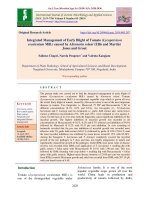
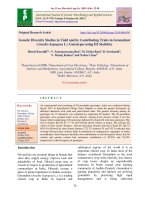


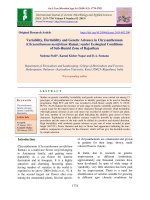
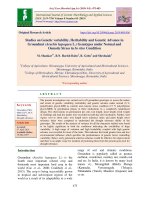
![Studies on genetic variability, heritability and genetic advance in F2 segregating population of Cross Arka Archana × AAC-1 in China Aster [Callistephus chinensis (L.) Nees]](https://media.store123doc.com/images/document/2020_01/14/medium_pyb1578991636.jpg)
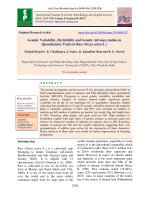
![Studies on genetic variability, heritability and genetic advance in F4 population of china aster [Callistephus chinensis L. (Nees.)]](https://media.store123doc.com/images/document/2020_03/02/medium_mqh1583125904.jpg)
